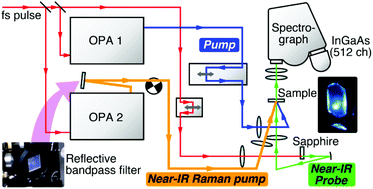Development of a femtosecond time-resolved near-IR multiplex stimulated Raman spectrometer in resonance with transitions in the 900–1550 nm region
Abstract
Charge transfer and charge delocalisation processes play key roles in the functions of large biomolecular systems and organic/inorganic devices. Many of the short-lived transients involved in these processes can be sensitively detected by monitoring their low-energy electronic transitions in the near-IR region. Ultrafast time-resolved near-IR Raman spectroscopy is a promising tool for investigating the structural dynamics of the short-lived transients as well as their electronic dynamics. In this study, we have developed a femtosecond time-resolved near-IR multiplex stimulated Raman spectrometer using the Raman pump pulse at 1190 nm and a broadband probe pulse covering the 900–1550 nm region. Spectral and temporal instrument responses of the spectrometer are estimated to be 5 cm−1 and 120 fs, respectively. Time-resolved near-IR stimulated Raman spectra of poly(3-dodecylthiophene) (P3DDT) are recorded in toluene solution for investigating its structural changes following the photoexcitation. The spectra strongly indicate conformational changes of P3DDT in excited states associated with the elongation of its effective conjugation length. The results on P3DDT fully demonstrate the effectiveness of the newly developed femtosecond time-resolved near-IR stimulated Raman spectrometer.


 Please wait while we load your content...
Please wait while we load your content...